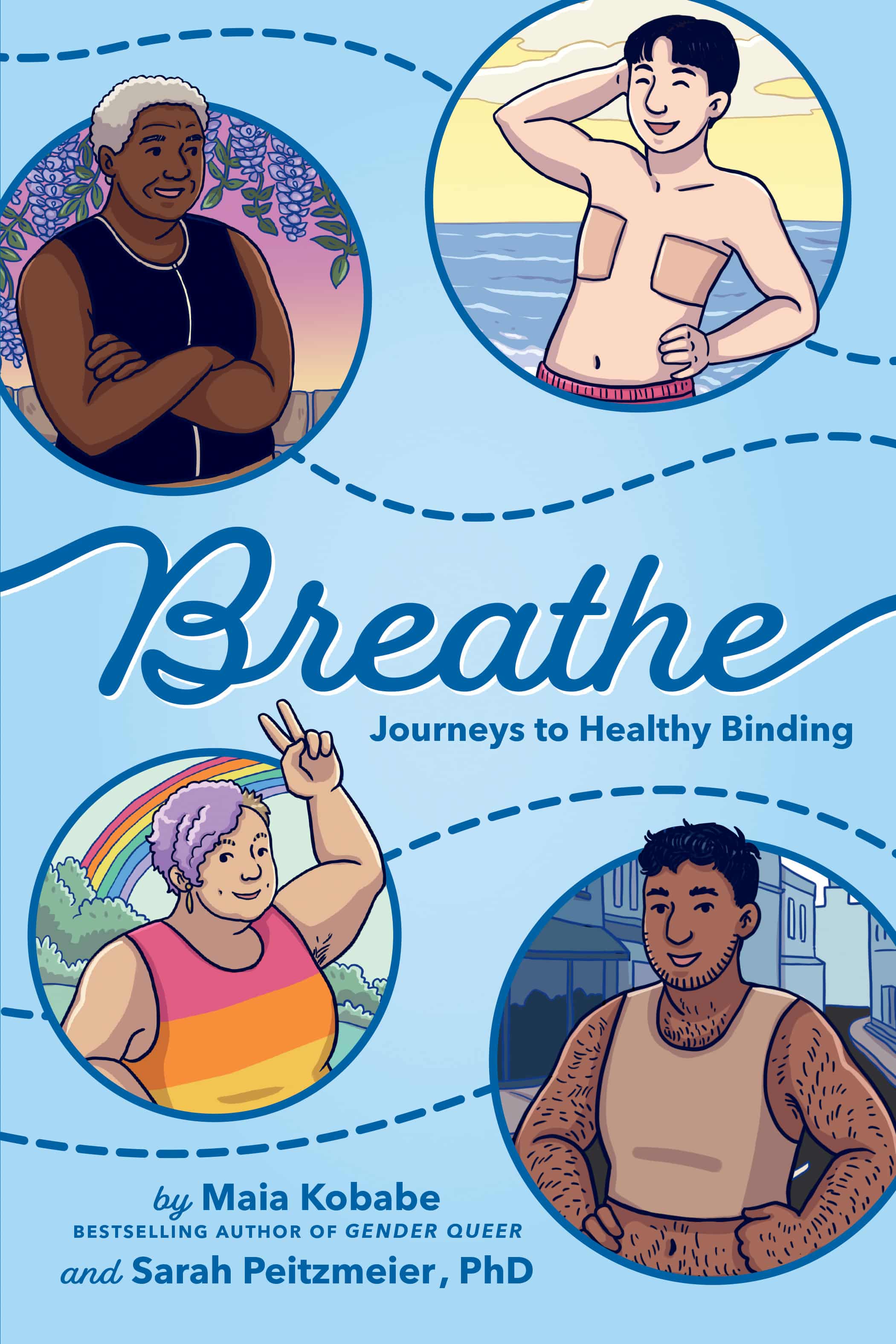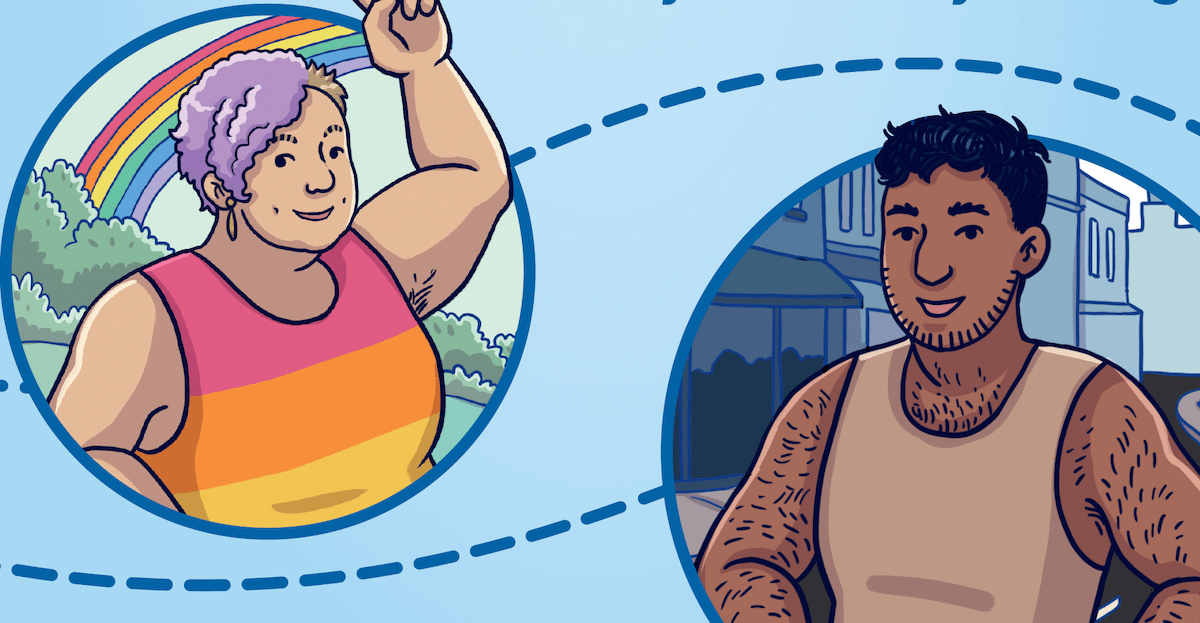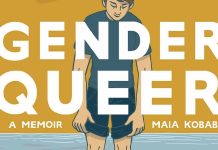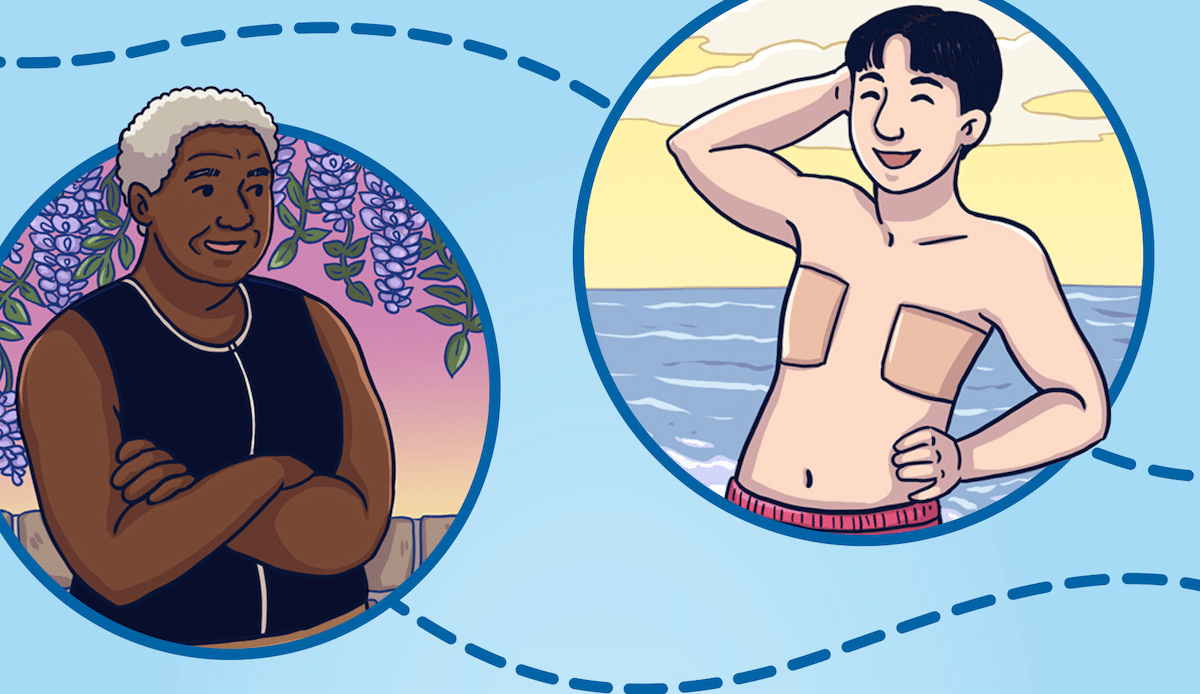In Breathe: Journeys to Healthy Binding by Maia Kobabe and Sarah Peitzmeier, PhD, readers will find a “graphic guide to chest binding with real-life stories and research-backed advice.” The title combines sequential graphic narrative with workbook-style pages to provide an excellent resource that would only be possible through the power of comics!
To celebrate the publication of Breathe on Tuesday, May 7th, 2024, Comics Beat caught up with Kobabe and Peitzmeier over email. We asked all about the origins of the book, about how comics are uniquely suited to this type of title and about the possibility of future books in a similar format.

AVERY KAPLAN: Can you tell our readers about the origins of this book? What was the catalyst/how did you get involved?
KOBABE: Sarah emailed me out of the blue in Spring 2020, when I was looking around for my next big comics project. I was immediately interested in her research around chest binding and the pitch of turning this more academic material into an accessible comic.
PEITZMEIER: At that time I was getting contacted pretty frequently by trans young people and their parents, doctors, and teachers asking for more info about my research, but they didn’t have access to paywalled academic journals to read more. Even if they did, research jargon can be pretty hard to parse! I was getting frustrated that the research I was doing wasn’t getting in the hands of people who actually needed to use it. I ran across the idea of creating comics to disseminate research and it lit me up. I had recently read Gender Queer and knew Maia was my dream collaborator. Happily e agreed!
KAPLAN: What was the process of collaborating together on Breathe like? What was working with the additional team members on the book like?
KOBABE: The first thing Sarah shared with me was a 35 page word document full of quotes from research participants. This was a pretty intimidating document to receive, but Sarah and her team had already done a lot of work to combine the quotes into several different storylines, and these loose story outlines became the first seed of the book. Once we had refined the four characters, we consulted with Frances Reed (a licensed massage therapist) and Meaghan Ray Peters (a physiotherapist) on stretch exercises we could include which would most benefit folks experiencing some body stress due to binding.
PEITZMEIER: Collaborating was really a joy for me. We passed the draft back and forth many times, riffing off each other and sometimes letting each other know if there was a part that wasn’t working for us for some reason and then figuring it out together how to make it right.
Frances was another cold email I sent out to a dream collaborator who graciously responded and was game to join the team! Meaghan Ray had actually cold emailed me about a separate research idea around the same time, and I thought they would be perfect to join the team, too. There are so few people working in binding research and clinical practice that I think we were all excited to find each other, and I was so grateful to be able to include their complementary expertise and perspectives as a bodyworker and a physical therapist.

KAPLAN: I want to ask about the book’s unique structure. There’s an introductory page, a section with four individual’s stories, and then a workbook section. How did these pieces fall into place?
KOBABE: The four characters developed out of an attempt to capture the diversity of experience reflected in the interviews with Sarah’s research participants. Sarah also came to me with the idea to include some of the workbook and journal prompt pages, which ended up getting expanded as we continued to work on the draft. The last part of the book that we wrote was the four concluding pages, digging into some of the data and statistics from Sarah’s research.
PEITZMEIER: One finding that emerged from our research is that people often had the most symptoms and issues with binding if they thought there was only One Way to bind. If there’s only one single way, then when you run into road bumps the choice is to either keep binding the exact same way, or stop binding all together. Our goal with showing multiple character arcs was to show that binding can look so many different diverse beautiful ways. It’s one thing to tell people that, it’s another thing to show it and illustrate it and tell these stories so that it really sinks in. And I think for people to know that the stories are drawn from real-life journeys with binding is powerful. That’s one of the big things that got me really excited about comics as a medium. The workbook pages allow us to deliver some messages a little bit more directly, but I don’t think they would have worked as well without the stories to illustrate some of the concepts first and for us to build some trust with our readers.
The introductory page and the last few pages summarizing research data were Maia’s ideas – as a researcher I was trained to present my data, not myself, but Maia insisted it was important for Kieran and I to introduce ourselves at the beginning so that people knew where the research was coming from before we jumped into the stories. As uncomfortable as it felt for me at first, I’m so glad I trusted eir instincts on how to start and end the book.
KAPLAN: Do you see this book as a potential blueprint for future volumes on other trans topics?
KOBABE: I would personally love to see more books like this in the future! We don’t have another one in development, but I’d be happy to see more researchers or scientists pairing with cartoonists to share their work.
PEITZMEIER: I haven’t seriously pitched this to Maia or anyone else yet (!), but I’d love to take some of my research on intimate partner violence in trans communities and bring it to life in a comic like this. We hear so directly from participants that it was hard to recognize what they went through as abuse because trans people are not represented in typical stories about domestic violence. Showing some of the journeys shared by our participant survivors through art and storytelling in comic format I think would be very powerful. I think these stories could highlight the resilience and resistance of trans survivors, too.
KAPLAN: What went into selecting the four featured stories? Are these individuals purely composites from the interviews as a whole? Was the process of distilling these stories into four short comics like?
KOBABE: The four characters are all composited from interview quotes. It was important that we maintained the anonymity of the research participants, plus this gave us the flexibility to combine and clarify similar stories.
PEITZMEIER: Yes, other than a few words here or there for flow, they’re all direct quotes! Before I sent Maia that gargantuan 35 page document e mentioned earlier, I sat down with my research team and we thought about what core concepts and themes we wanted to represent in the stories that ended up in the book. We took hundreds of pages of interview transcripts and identified quotes that spoke to each of those themes across the participants. From that sprawling document, we tentatively teased apart the three original characters (fun fact, we added D’s story later when Maia and I felt like the book was missing someone, and D made it feel complete!) and we winnowed down the quotes that could possibly inform each character into that 35 page document. We also took a look at the demographics of the research participants contributing to the book to make sure we had included a really diverse group of folks.
KAPLAN: What makes comics the ideal format for Breathe?
KOBABE: I am obviously very biased in favor of comics as a medium! But truely, I think there’s something magic that happens when words and images come together. I think they can convey a very rich and dense amount of information in a very small space, and illuminate subjects it might be hard to tackle with words or images alone.
PEITZMEIER: Trans health is such a contested space right now. I was publishing dense academic articles that presented data and outlined recommendations for what binding practices appeared to be associated with less physical risk, but even if someone managed to reach the paywalled article, why should they trust me and how can they make sense of a recommendation that is totally divorced from the context of their life? Comics let us put the findings and recommendations in the context of the lives of the four characters, and allowed me to be in dialogue with readers in a different way. On the flip side, I had also seen some of my research on the side effects of binding taken out of context and misused by anti-trans activists to argue that binding is inherently dangerous. I was intrigued by the possibility of an arts-based medium to resist manipulation in this way.
KAPLAN: Did Breathe have any particular inspirations? I notice there are a lot of trans comics that make cameo appearances!
KOBABE: I am a voracious reader, and a particular fan of memoir and biography. I wouldn’t say I was inspired by any specific other text, but I did try to include as many references to other trans, nonbinary and queer books as I could!
PEITZMEIER: I love all the shout outs to other books that Maia wove throughout. I’m not sure if I have ever admitted this to Maia, but I actually had read very few comics coming into this collaboration. In an effort to not be a terrible collaborator, I went on a months-long binge of reading comics, especially graphic medicine and memoir, to educate myself when we started working together. One artist that stood out to me in particular from that period of intensive reading is queer artist Ellen Forney’s work. She wrote a memoir Marbles about her experience with bipolar disorder and then a companion “self-help guide” Rock Steady with more tips and tricks about managing bipolar. While we had already had the idea of having a two-part book with stories followed by workbook pages, seeing her approach to story + guide was inspiring and helpful.
KAPLAN: Who do you hope finds their way to this book, and what do you hope they take from it?
KOBABE: I was thinking of three primary audiences while working on this book: young people who want to try binding for the first time but don’t know much about it; the parents of young people who might have doubts or concerns about the safety of binding; and folks who are already binding, but interested to learn more about how to use it holistically as one of many tools available to affirm gender.
PEITZMEIER: We want people to know that it doesn’t have to hurt to be yourself, that you can change your binding practice so that it works better for you, and that you deserve to have resources, information, and support along that journey.
KAPLAN: Is there anything else you’d like me to include?
KOBABE: As we worked on this book, we watched a huge rise in the number of anti-trans healthcare bills rise in the US. The book took on a new urgency as we continued to shape it. I am very happy to be releasing this book now since binding is a type of trans affirming care which doesn’t require a doctor’s diagnosis and can often be done quite privately or even secretly if needed. I want to make sure anyone who has to bind in an unsupportive environment still has access to the best, researched-backed advice on how to do so safely and gently on their body!
Breathe: Journeys to Healthy Binding will be available at your local bookstore and/or public library beginning on May 7th.












